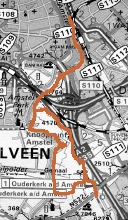Gordon Mumma and Robin Hayward at DNK
I had just read a new text by Douglas Kahn in which he refers to works by Gordon Mumma, so the programming of a tape piece by Mumma at DNK came at exactly the right time. It was a cold night, and at 22.00 there were still only about 7 people: exceptionally quiet for a DNK concert. It might have been the cold, it might have been the promise of a tape piece. Martijn Tellinga did a short eloquent introduction and played Mumma’s Megaton for William Burroughs. I do not know why he chose that particular piece, but it was nice. Sometimes harsh sounds, also very beautiful spatializations over two speakers. And then something strange happened in the sound, a soft knock, a sound that sounded like a very cautious footstep. I had my eyes closed so I didn’t see anything. It happened a few times more. When after a while I opened my eyes I saw that the light behind the curtains had come on. After the piece was over – it ends with a recording of a drummer playing a steady rhythm on cymbals – it turned out that about nine people had been let in, through the entrance behind the curtains, to not disturb. Seamus Cater wasn’t amused, and it did destroy some of the enjoyment of the piece, but in a sense, it was quite funny – most of the nine behind the curtains were regular DNK-visitors, and I couldn’t be mad at them.
After the break it was Robin Haywards, solo on tuba. I’ve hear him a few times before – never solo – and you know you’re in for very quiet, intens music. I love the sound of the tuba, and sometimes I find myself craving for ‘some real tuba’ by Hayward (I can image that he can produce beautifull conventional tones on the tuba too). Hayward focusses exclusively on the ‘other’ sounds of the tuba, the breath, air through the tube without producing a note, flurries, noises, using circular breathing. He played 4 pieces (or imporvisations), in the first two he focussed on the noises and breathing, in the third one he did make a tone, or almost. He produced amongst others flurries of notes that sounded like, yeah what, the membrane of a loudspeaker moving physically, flabbing, producing both a tone, external noises and some overtones (?), all at the same time, and he build a pulse from that. I was impressed more than ever before by his playing. There are vast unexplored worlds in very soft sounds. The fourth piece – he was already playing for quite a long time, much longer than I’d anticipated – was cut off by someone leaving. He took that as the call to stop. It was late already.
